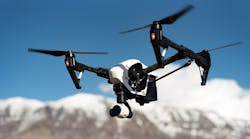Growing interest in counter unmanned aerial systems (c-UAS) solutions is one indication of the increasing use of UAS-based approaches to warfare. As small drones are used more for surveillance and countermeasures, drones are also developed as part of electronic counter measures (ECM) against those drones. One of the suppliers pursuing force protection from drones by means of c-UAS solutions is Citadel Defense which recently announced $9.2 million in orders during the first two months of 2020 for its compact autonomous Titan c-UAS systems.
The need for C-UAS solutions is expected to extend across military applications but in commercial and industrial markets as well. Citadel Defense Titan c-UAS systems employ a proprietary RF detection method based on machine learning (ML) and artificial intelligence (AI) to identify threat signals. The approach can take advantage of high-speed signal processing for rapid categorization of many different detected radio signals within range and to provide the means to detect the threats represented by different small UAS (sUAS) approaches.
“Drones are an asymmetric threat that require unprecedented speed for innovation. Citadel’s AI capabilities and responsiveness give customers a cost-effective option that addresses a very large portion of the sUAS threat,” said Christopher Williams, CEO of Citadel Defense. “Strong warfighter references and combat-proven results over the last two years helped secure this order.”
The Titan c-UAS systems rely on up-to-date software to respond to new threats and the company updates its software in a timely fashion. If the Titan AI algorithms do not detect and identify a threat immediately, the company can deliver an end-to-end capability in 72 hours that will counter most drones. For the most difficult challenges, it can provide software solutions in less than four weeks for the most complex drone signals. The detection and identification algorithms are backed by adaptive countermeasures to quickly develop a means of jamming or defeating an unwanted drone signal. As Williams explains: “Our AI approach allows us to quickly address new threats without the risks or uncertainly that comes with hacking the drone link.”
